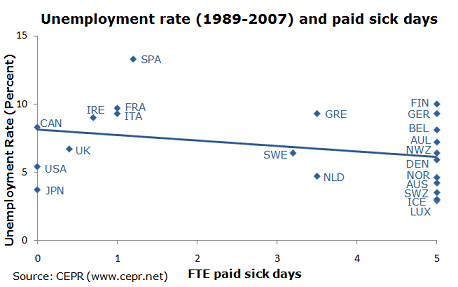June 11, 2009
June 11, 2009
Better Paid Sick Day Policies Don’t Mean Job Loss
For Immediate Release: June 11, 2009
Contact: Alan Barber, 202-293-5380 x115
Washington, D.C.- As Congress holds a hearing today on the Healthy Families Act (HFA) — legislation that would guarantee workers up to seven paid sick days per year — a new study from CEPR finds that mandatory paid sick days do not lead to higher unemployment.
The report, “Paid Sick Days Don’t Cause Unemployment,” examines the connection between government-mandated paid sick days and the national rate of unemployment in a sample of 22 highly developed countries. The CEPR study found no statistically significant relationship between national unemployment rates and legally-mandated paid sick days in these countries, which all have the same level of economic development as the United States.

“Despite frequent claims to the contrary from some in the business community, we found no correlation between paid sick days and unemployment,” said John Schmitt, a Senior Economist at CEPR and a coauthor of the report. “Guaranteeing paid sick days does not put countries at a competitive disadvantage.”
Legislation like the Healthy Families Act, sponsored by Sen. Ted Kennedy and Rep. Rosa Delauro, would give workers the right to take up to seven paid sick days per year to recover from illness or care for sick family members.
The findings of the report yield no evidence suggesting that such policies will contribute to more job loss here in the United States. However, these policies could pay off economically by restricting the costly spread of contagious diseases.
“The economic costs of a serious flu outbreak are potentially enormous,” said Dr. Jody Heymann, Director of the Institute for Health and Social Policy and Professor of Epidemiology at McGill University and also a coauthor of the report. “The lack of paid sick days in the United States puts Americans at substantially greater risk of contagious diseases — from the flu which kills thousands annually to diarrheal disease, respiratory infections, and the threat of new diseases like the H1N1 flu virus.”
###






